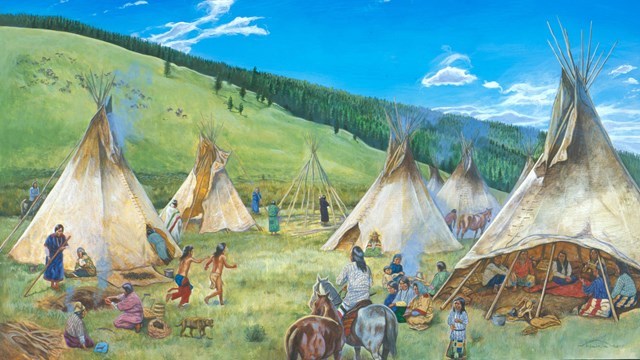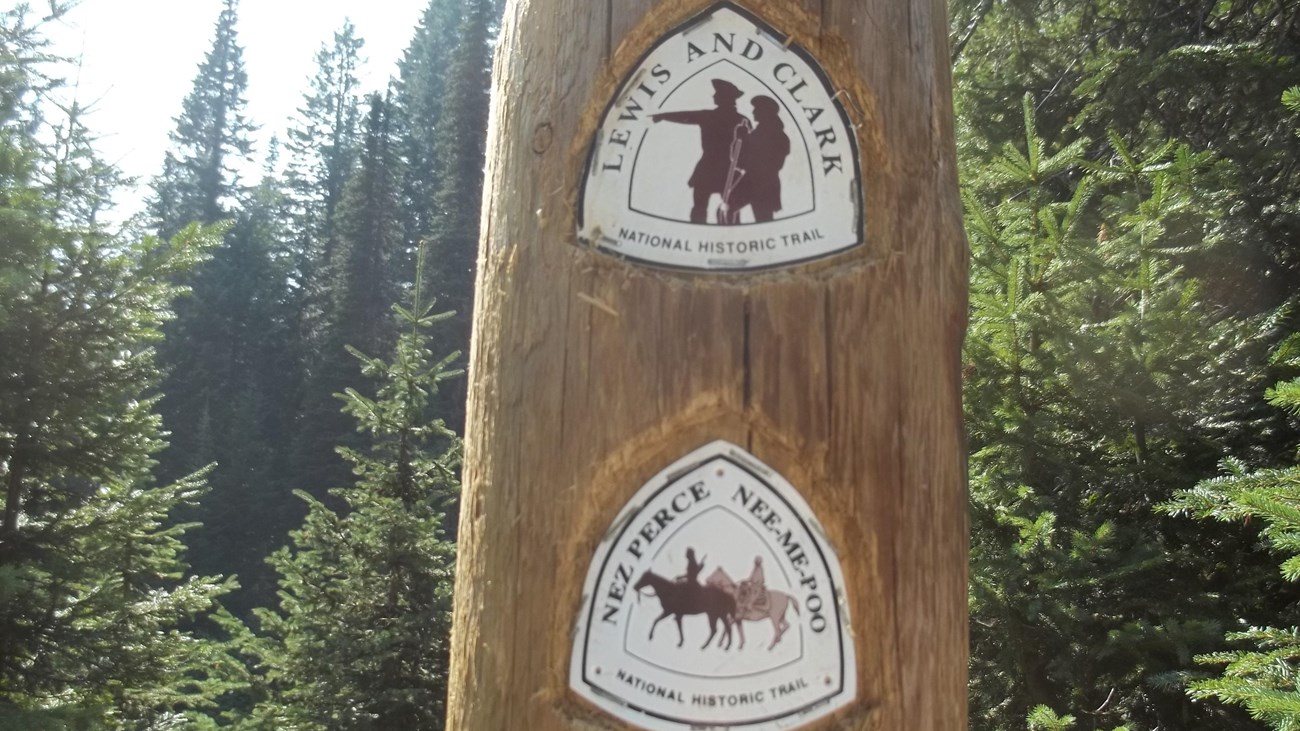K'useyneisskit - Road to the BuffaloThe route over the Bitterroot Mountains, known today as the Lolo Trail, was used by the Nez Perce long before Euro-Americans came on the scene. Extending from Weippe Prairie to Lolo Pass along the Idaho-Montana border, it was the primary route over the Bitterroot Mountains into western Montana and the northern Great Plains. The route offered access to hunting, fishing, and food gathering areas and enabled trade with other tribes. It also led to bison on the eastern plains. Lewis and Clark ExpeditionLewis and Clark struggled over the Lolo Trail in September, 1805. What was thought to be a five day journey turned into an arduous journey of eleven days over snow covered hill tops and ridges. Led by a Lemhi Shoshone guide known to the expedition as "Old Toby", they began their journey on September 12. By the 16 and 17, they were hit by severe snow storms that slowed progress significantly. There was also a scarcity of game on the ridge tops, forcing the expedition to eat some of its ponies and emergency rations. As they reached the southern end of the trail, Clark took a small party of hunters ahead of the main party to search for game and make contact with the Nez Perce, which they did on September 20. Nez Perce Flight of 1877During July of 1877 this traditional trail, which had long been a source of joy and sustenance, became a trail of flight, conflict, and sorrow for the non-treaty bands of the nimíipuu (Nez Perce). July 12The nimíipuu withdraw from the Clearwater Battle and camp that eveing near Kamiah, Idaho. Troops occupy and plunder the former nimíipuu camp on the South Fork of the Clearwater River. July 13The non-treaty nimíipuu cross the Clearwater River at Kamiah, Idaho. July 15The non-treaty nimíipuu move to and camp near Weippe. July 16After struggling against the U.S. army for four weeks, the non-treaty nimíipuu bands head east on the Lolo Trail, hoping to find safety in Montana. Musselshell Meadows was the site of their first camp after leaving the Weippe Prairie. Imagine for a moment you are a young nimíipuu about to leave the land where you were born, where you played as a child, where you fished or gathered camas as an adolescent. Imagine leaving the land where your grandparents were buried, not knowing if you would ever return. These thoughts must have captured the minds of the nimíipuu as they camped in this meadow. Meanwhile, the U.S. Army camped upon Temme ilpílp's (Chief Redheart) band on the Weippe Prairie. There were about 20 men, women, and a few children in this camp who were returning from Montana. They had not joined the bands on the flight, but had only met and bid them farewell. One of General Howards Nez Perce scouts came riding in and told them, "It will be best to come on your own reservation. There you will be safe." Most of them answered, "We will go." Instead, they were marched 60 miles on foot in irons in the heat of July to Lapwai, then later sent by boat from Lewiston, Idaho to Fort Vancouver, Washington, where they remained prisoners until April 1878. July 17Not far from Incendiary Creek, a rear guard of the fleeing non-treaty nimíipuu ambushed a scouting party that General Howard had sent ahead of his other troops. Lepeet Hessemdooks (Two Moons) described the encounter: "...See, we have passed over some of the worst trails and still they keep after us... Let our families travel on while the warriors go back to where we can lay for the enemies. We hid in the brush to get them at close range. Soon the voices grew. It was Nez Perce scouts. Christians of our tribe, working for the government against their own tribe, their own blood people. Rainbow took a shot and wounded one of them . Other shots were fired and I do not know if any others of them were struck." The scout who was hit, Sheared Wolf/John Levi, died from his wounds. July 24Two companies of the 7th Infantry with Captain Rawn, supported by over 150 citizen volunteers, constructed a log barricade near Lolo Creek at what became known as Fort Fizzle. July 25The non-treaty nimíipuu arrived at Lolo Hot Springs, well ahead of the army. Duncan McDonald, a Nez Perce man who reported on the flight in local area newspapers, wrote: "When the Nez Perce camp reached the Hot Springs on the Lolo Trail... three Indians met them in their camp. One of these Indians was Nez Perce, but his home was in the Bitter Root Valley. He told Looking Glass there were some soldiers on the trail watching for them to come." The soldiers he spoke were under the command of Captain Rawn at Fort Fizzle. July 26The non-treaty nimíipuu meet with Captain Rawn at Fort Fizzle to make several things very clear.
July 28Soon after the meeting on July 26, many settler volunteers returned home. Some reports say they were convinced that the Nez Perce wanted a peaceful trip through the Bitterroot Valley. July 30General Howard leaves Kamiah and camps at Weippe. July 31General Howard's command camps at Musselshell Meadows, more than two weeks after the fleeing non-treaty nimíipuu had passed through. August 6General Howard established a five-hour breakfast camp with his cavalry and infantry in Parker Meadows, a favored gathering site for nimíipuu to gather roots and other food sources. That night his command camped at Lolo Hotsprings, nearly two weeks after the fleeing non-treaty nimíipuu had passed through.

Big Hole National Battlefield History
On the morning of August 9, 1877, U.S. troops surprised the Nez Perce killing 60 to 90 Nez Perce men, women, and children. 
The Nez Perce Flight of 1877
In 1877, the non-treaty Nez Perce were forced on a 126-day journey that spanned over 1,170 miles and through four different states. 
Visit Lolo Trail and Pass
Visit the trail used by Lewis and Clark in 1805 and 1806 and the Nez Perce in late July of 1877. Located on the Idaho/Montana border. Nez Perce Trail Auto TourThe staff at the Nez Perce National Historic Trail have developed auto tours with travel instructions for retracing the 1877 route of the Nez Perce along with maps, graphics, and details about the confilct at sites you can see along the way. Download Auto Tour 2 and Auto Tour 3 for more details about the what occured along the Lolo Pass and Trail during the Nez Perce Flight of 1877. |
Last updated: December 30, 2022
